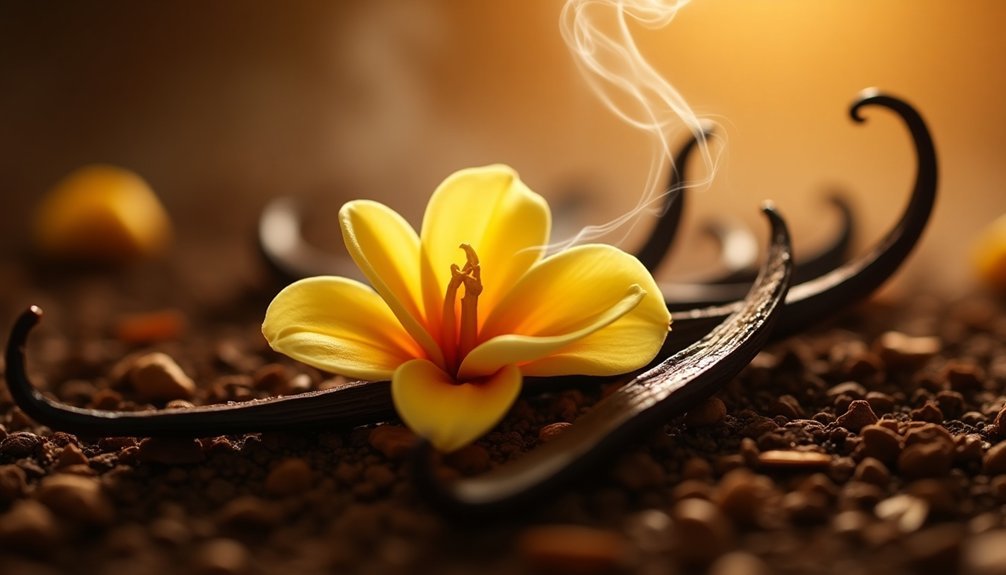Cedarwood and patchouli layer beautifully together due to their shared molecular structure and complementary characteristics. You'll find cedarwood's warm, woody notes naturally enhance patchouli's deep, earthy qualities, while their common sesquiterpene molecules create exceptional stability. The two essential oils act as natural fixatives for each other, resulting in a long-lasting, grounding blend. Exploring their ideal ratios and enhancing elements can elevate this timeless combination to new heights.
The Natural Synergy Between Earth and Wood

When nature's finest elements come together, the combination of cedarwood and patchouli creates a masterful fusion of earth and wood.
You'll discover how these two powerful ingredients complement each other perfectly, with cedarwood's warm, woody notes enhancing patchouli's deep, musky character.
The natural origins of these fragrances contribute to their seamless blending.
While cedarwood brings its rich, resinous qualities from ancient trees, patchouli offers its earthy essence from aromatic leaves.
Together, they create a grounding experience that's both authentic and long-lasting.
You'll appreciate how the cedarwood amplifies the longevity of patchouli, ensuring your scent remains present throughout the day.
This harmonious duo delivers a balanced profile that speaks to those seeking a genuine connection with nature's most enchanting aromas.
Breaking Down the Individual Notes
Although each component brings its own distinct personality to the blend, understanding the individual characteristics of cedarwood and patchouli helps you appreciate their synergy.
When you explore cedarwood, you'll discover a warm, woody scent that provides a stable foundation for fragrance notes. Its balsamic undertones create a grounding effect that anchors other scents in your blend.
Patchouli contributes a deep, earthy character with sweet and spicy elements that naturally complement cedarwood's base.
You'll notice how these two ingredients work together to create a more complex and lasting fragrance. Both elements act as natural fixatives, meaning your scent will last longer when you combine them.
Their individual strengths merge to produce a balanced composition that's both sophisticated and comforting.
Chemical Compatibility and Molecular Structure

The molecular chemistry behind cedarwood and patchouli's compatibility explains their exceptional layering potential. Their shared sesquiterpene molecules create a natural chemical compatibility that you'll notice in their lasting, grounding effects. When you layer these fragrances, the molecular structure of cedarwood's cedrol and thujopsene works harmoniously with patchouli's patchoulol.
| Component | Characteristic |
|---|---|
| Sesquiterpenes | Heavy, long-lasting molecules |
| Cedrol | Sweet, woody compound |
| Thujopsene | Sharp, cedar notes |
| Patchoulol | Rich, earthy element |
| Combined Effect | Stable, evolving blend |
You'll find that this chemical stability guarantees your layered fragrance maintains its integrity throughout wear, while the complementary molecular structures create a deep, complex scent that develops beautifully on your skin.
Blending Ratios and Proportions
Perfect blending ratios transform cedarwood and patchouli from individual scents into a sophisticated fragrance symphony.
You'll find that combining these fragrance oils at a 2:1 ratio creates an ideal foundation, with cedarwood's grounding qualities complementing patchouli's earthy depth. For best scent chemistry, aim for approximately 58% cedarwood and 25% patchouli in your blend.
Before committing to large batches, test your combinations on cotton balls using different cedarwood varieties like Atlas or Virginian. Each type brings unique characteristics to your blend.
You can enhance the formula by adding a bright note such as orange, which lifts the overall composition. This method of experimentation allows you to fine-tune your ratios until you achieve the perfect balance between woody and earthy elements.
Common Amplifying Elements and Enhancers

Building upon your cedarwood and patchouli foundation, specific elements can intensify and elevate your layered fragrance.
You'll find that adding warm, resinous notes like amber or vanilla can amplify the earthy qualities these two scents naturally share. Benzoin and sandalwood work particularly well to enhance the woody aspects of both cedarwood and patchouli while maintaining their harmonious balance.
To boost longevity, consider incorporating fixative elements like vetiver or oakmoss.
These natural enhancers help lock in the deep, musky characteristics of your layered combination while adding depth to the overall scent profile.
When layering these amplifying elements, you'll notice they don't just extend wear time – they also create a more complex and sophisticated fragrance that maintains the grounding properties of your cedarwood-patchouli base.
Frequently Asked Questions
Do Cedarwood and Patchouli Go Together?
Yes, you'll find cedarwood and patchouli work beautifully together. Their shared earthy, woody qualities create a balanced, long-lasting fragrance that's both grounding and versatile for any occasion you choose.
What Layers Well With Patchouli?
You'll find patchouli layers beautifully with vanilla and amber for warmth, florals like rose and jasmine for balance, citrus notes for brightness, woody scents like cedarwood for depth, and spices for complexity.
Why Do Stoners Use Patchouli Oil?
You'll find stoners use patchouli oil for its masking abilities to cover cannabis smell, its connection to 1960s counterculture, and its calming properties that enhance their relaxation during smoking or meditation sessions.
What Fragrances Layer Well Together?
You'll find citrus notes pair beautifully with vanilla, while lavender complements bergamot. Woody scents like sandalwood blend well with rose, and jasmine works wonderfully with amber. Mix light with deep notes for balance.
In Summary
You'll find that cedarwood and patchouli's natural harmony stems from their shared earthiness and complementary molecular structures. When you're blending these notes, remember that their similar volatility rates allow them to evolve together beautifully. Whether you choose a 1:1 ratio or experiment with different proportions, you can enhance their synergy further by adding touches of vanilla, bergamot, or sandalwood to amplify their best qualities.




Leave a Reply